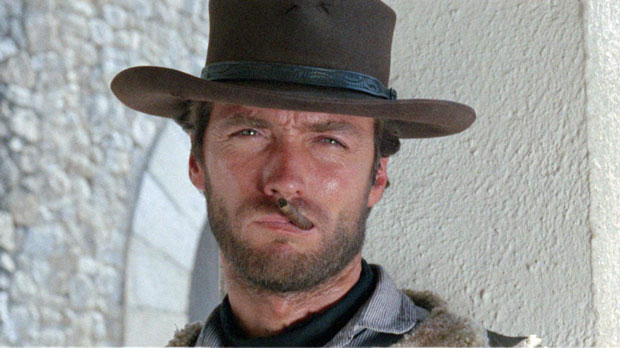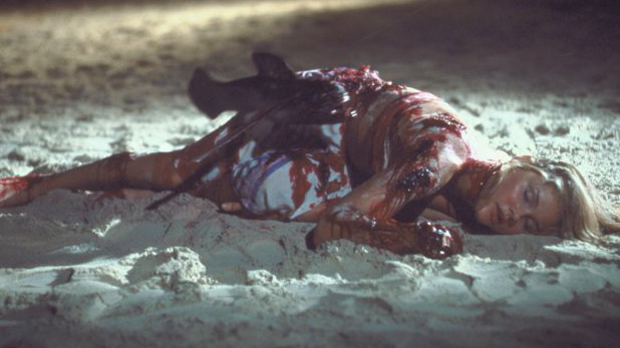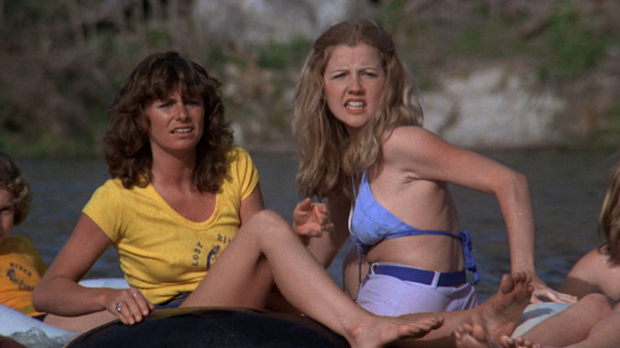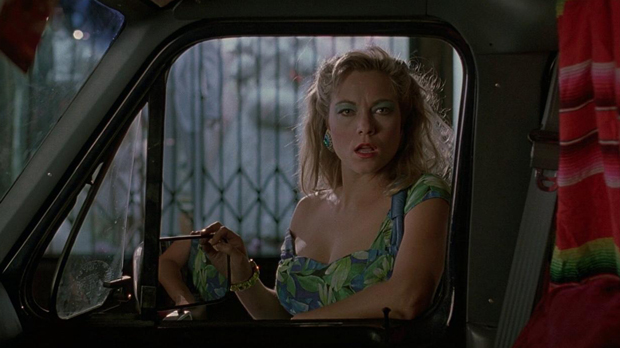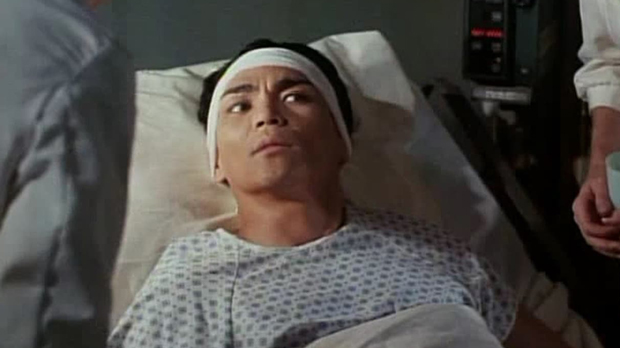
A Fistful of Dollars (1964) United Artists/Western RT: 100 minutes Rated R (violence) Director: Sergio Leone Screenplay: Victor Andres Catena, Jaime Comas and Sergio Leone Music: Ennio Morricone (as “Dan Savio”) Cinematography: Massimo Dallamano (as “Jack Dalmas”) and Federico G. Larraya Release date: September 12, 1964 (Italy)/January 18, 1967 (US) Cast: Clint Eastwood, Marianne Koch, Gian Maria Volonte, Wolfgang Lukschy, Sieghardt Rupp, Joseph Eggar, Antonio Prieto, Jose Calvo, Margarita Lozano, Daniel Martin, Benito Stefanelli, Mario Brega, Bruno Carotenuto, Aldo Sambrell, Nino del Arco. Box Office: $14.5 million (US)
Rating: ****
CINEMATIC FORMULA: Leone + Morricone + Eastwood = AWESOME!!!
FACT! Clint Eastwood is one of the most iconic actors in film history. When one thinks of Clint, two images typically come to mind. You either see him pointing a .44 Magnum at a punk or standing tall with a cigar clenched in his teeth. The first, of course, is Dirty Harry. The second is known as “The Man with No Name”, the anti-hero protagonist of three spaghetti westerns directed by Sergio Leone (One Upon a Time in the West). The first, A Fistful of Dollars, is the one that made Eastwood a movie star.
A remake of Akira Kurosawa’s Yojimbo, Eastwood plays an unnamed stranger that rides into the border town of San Miguel and immediately senses an opportunity to make money. He’s ridden right into the middle of a war between two rival families, the Rojos and the Baxters, fighting for total control of the town. The Man decides to play both ends against the middle to his own financial gain. What he doesn’t count on is finding a conscience upon discovering that the mistress Marisol (Koch, The Devil’s General) of lead Rojo brother Ramon (Volonte, The Terrorist) is actually being held against her will. Her husband and young child are prevented from seeing her by Rojo and his gang. What’s an opportunist to do in this situation?
A lot of time, it’s a particular scene that transforms an actor into a bona fide star. For Eastwood, it’s an early scene from A Fistful of Dollars. The Man, about to confront members of Baxter’s posse, says, “Get three coffins ready” as he passes the town coffin builder. He exchanges a few words with the men, mostly about how they hurt his mule’s feelings with their taunts as he rode into town, before shooting down all four in quick succession. When he passes the coffin maker again, he says, “My mistake. Four coffins.” It’s still cool more than 50 years later. The Man with No Name has become one of the most iconic western characters in film history with his trademark poncho, hat, six-shooter and cigar. Add in Eastwood’s distinctive hard stare and whispering growl (when he actually speaks) and it’s magic time! It goes without saying that Eastwood rides high in the saddle in A Fistful of Dollars. You can’t measure his performance against other western actors because he’s in a class of his own. All I can say is he’s GREAT!
Leone set out to redefine the western genre with A Fistful of Dollars. He felt that Hollywood oaters had grown stagnant and preachy by the 50s. He wanted realism, but also to lend an operatic feel to the proceedings. He demystifies the Old West by offering a grim view of life and death (mostly death) in dusty, dirty towns with their bleached-out structures and barren land as far as the eye can see. The saloon isn’t a crowded, bustling joint with card-players, saloon girls and a piano player working the keys non-stop. Other than The Man, I never saw a single customer in the place. It’s probably because decent folks stay in their homes out of fear of the criminal element that runs the town. As for heroes, there aren’t any, not really. Some people are just less bad than others.
I LOVE how Leone frames his shots. He employs his characteristic visual style, one defined by frequent close-ups of his characters’ faces, their eyes in particular, to great effect. It often looks like they’re posing for portraits. He receives ample assistance from cinematographers Jack Dalmas and Federico G. Larraya working in perfect conjunction with set designer/art director Carlo Simi. Together, they create a work that’s as visually stunning as it is exciting. In addition to all else, Leone has an excellent sense of pacing that might seem too slow to young 21st century audiences. It wasn’t always about instant gratification, kids. It’s thrilling to feel the tension build as Eastwood and his opponents stare each other down before firing their guns.
My favorite aspect of A Fistful of Dollars (and its sequels) is Ennio Morricone’s beautiful score. It definitely augments the operatic tone Leone is going for. He often kept scenes going because he didn’t want the music to end. Morricone’s arrangements are positively brilliant. I especially love how he incorporates whistling as a means of illustrating the wandering main character’s loneliness, the result of an inability to form friendships due to him always being on the move. I’ll say it now; Morricone is my all-time favorite film composer. He could do no wrong as far as I’m concerned.
The Man with No Name trilogy is one of my favorites. A Fistful of Dollars is a terrific start. It’s violent, beautiful, exciting, haunting and just plain cool. It has a great anti-hero, horrible villains and a gorgeous damsel in distress. It really is an incredible piece of work. I’d even go so far as to call it art. If any filmmaker can be regarded as an artist, it’s Sergio Leone. This movie is proof of that.
TRIVIA TIDBIT: Yojimbo inspired two other movies, the sword-and-sorcery actioner The Warrior and the Sorceress (1984) and the Depression-era gangster movie Last Man Standing (1996).

